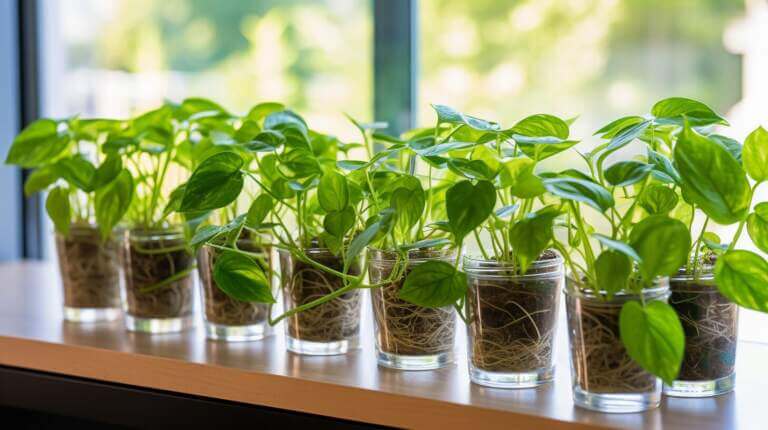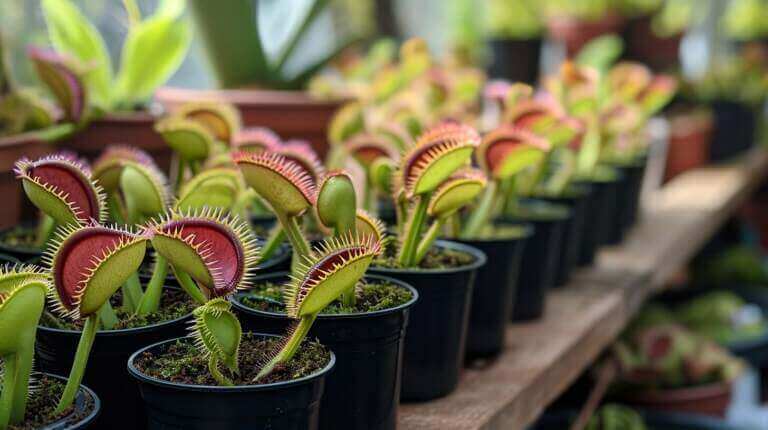Greetings, fellow plant enthusiasts! Today, I will be breaking down the essential care guidelines for Ctenanthe plants. Whether you’re a seasoned plant parent or just starting your green journey, understanding the light, water, and soil needs of these beautiful foliage plants is crucial for their health and well-being.
Ctenanthe plants, such as the Ctenanthe burle-marxii ‘Amagris’, require moderate to difficult care. Their stunning leaves and unique patterns make them an eye-catching addition to any indoor space. To ensure their longevity and vibrancy, let’s dive into their specific care requirements.
Key Takeaways:
- Proper lighting is crucial for Ctenanthe plants, with indirect light being the ideal choice.
- Maintain a consistent level of moisture in the soil, allowing the top few inches to dry between waterings.
- Use a well-draining soil mix that includes organic matter for optimal growth.
- Provide a humid environment for Ctenanthe plants by misting or using a humidity tray.
- Keep an eye out for spider mites and repot the plants every two years.
Now that we’ve covered the basics, let’s explore each aspect of care in more detail. By following these guidelines, you’ll be well on your way to becoming a successful Ctenanthe plant parent!
Light Requirements for Ctenanthe Plants
Ctenanthe plants, such as the Ctenanthe burle-marxii ‘Amagris’, have specific light requirements to thrive. These plants prefer a well-lit location with indirect light. Direct sunlight can be too intense and cause dehydration and crisping of the foliage, especially for varieties with red under-leaves. It is important to find the right balance of light to ensure optimal growth.
The amount of light needed by Ctenanthe plants can vary depending on the season and the color of their leaves. Generally, they require moderately bright light but can tolerate slightly darker locations if they have red under-leaves. In such cases, they may require less soil moisture to prevent overwatering. If the leaves start to lose their vibrant colors or if the plant becomes leggy, it could be an indication of insufficient light.
To provide the ideal lighting conditions for your Ctenanthe plant, place it in a well-lit area away from direct sunlight. Indirect or filtered light, such as that through a sheer curtain or shade, is best. Monitoring the plant’s response to the light conditions is crucial for maintaining its health and aesthetics.
| Light Requirements | Light Intensity | Light Duration |
|---|---|---|
| Bright, indirect light | Moderate to bright (avoid direct sunlight) | 8-10 hours a day |
| Moderate light with red under-leaves | Lower light tolerance, but still bright | 8-10 hours a day |
| Darker locations | Lower light tolerance, avoid direct sunlight | 6-8 hours a day |
Remember to periodically rotate your Ctenanthe plant to ensure even exposure to light and prevent foliage leaning towards the light source. By providing the right amount and quality of light, you can help your Ctenanthe plant to grow and thrive.
Watering Guide for Ctenanthe Plants
Proper watering is crucial for the health and vitality of Ctenanthe plants. These plants require continual moisture in their soil to prevent dehydration and maintain their lush foliage. In this section, I will provide you with a comprehensive watering guide to ensure your Ctenanthe plants thrive.
Frequency of Watering
It’s important to allow the top few inches of soil to dry out between waterings for Ctenanthe plants. This helps prevent overwatering and allows the roots to breathe. In spring and summer, when the plant is actively growing, water once every week. As the colder months approach, reduce watering slightly and water every two weeks.
Watering Technique
When watering your Ctenanthe plants, it is recommended to use lukewarm water to prevent damage to the sensitive roots. If possible, collect rainwater and use it for watering, as tap water often contains chlorine and fluoride that can be harmful to the plant. If using tap water, let it stand for 24 hours before using to allow the chlorine and fluoride to settle.
Signs of Overwatering and Under-watering
Overwatering can lead to rapidly yellowing leaves, leaf spot disease, and root rot. On the other hand, under-watering can cause crispy or distorted growth, curled leaves, and yellowing. It’s important to strike a balance and ensure the soil remains consistently moist without becoming waterlogged.
| Signs of Overwatering | Signs of Under-watering |
|---|---|
| Rapid yellowing of leaves | Crispy or distorted growth |
| Leaf spot disease | Curled leaves |
| Root rot | Yellowing leaves |
By monitoring the soil moisture and observing the signs of overwatering and under-watering, you can adjust your watering routine to meet the specific needs of your Ctenanthe plants, ensuring they stay healthy and beautiful.
Soil Requirements for Ctenanthe Plants
Ctenanthe plants have specific soil requirements that contribute to their overall health and growth. It is essential to provide them with a well-draining soil mix that prevents waterlogging and root rot. Heavy and loamy soils should be avoided as they drain slowly and can lead to fungal diseases.
An ideal soil mix for Ctenanthe plants consists of a combination of charcoal, sphagnum, and perlite. These components help promote good drainage and prevent the soil from becoming overly saturated. Additionally, incorporating organic matter into the soil is crucial. Coco coir, peat moss, or shredded leaves can be added to provide nutrients and improve soil structure.
When repotting Ctenanthe plants, it is recommended to use the well-draining soil blend mentioned above. Repotting every two years allows for adequate root development and prevents the plant from becoming root-bound. Make sure to choose a pot with drainage holes to facilitate proper water drainage.
The benefits of using a well-draining soil mix for Ctenanthe plants:
- Prevents waterlogging and root rot
- Ensures proper drainage, reducing the risk of fungal diseases
- Allows for adequate root development
- Provides essential nutrients through the inclusion of organic matter
By understanding and meeting the soil requirements of Ctenanthe plants, you can create an optimal growing environment that promotes their overall health and vitality.
| Soil Requirements for Ctenanthe Plants | Benefits |
|---|---|
| Well-draining soil mix (charcoal, sphagnum, perlite) | Prevents waterlogging and root rot |
| Inclusion of organic matter (coco coir, peat moss, shredded leaves) | Provides nutrients and improves soil structure |
| Avoid heavy and loamy soils | Ensures proper drainage and reduces the risk of fungal diseases |
Maintaining Humidity for Ctenanthe Plants
As we’ve discussed earlier in this ctenanthe plant care guide, humidity is a crucial factor in successfully growing and maintaining these plants. Ctenanthe plants thrive in high humidity environments, which help to mimic their natural habitat. To ensure optimal growth and prevent any leaf-related issues, it’s important to provide the right humidity levels.
One way to maintain humidity is by creating a humidity tray. Simply place a tray or saucer filled with water near your ctenanthe plant. As the water evaporates, it will increase the surrounding humidity. Be sure not to let the plant sit directly in water, as this can lead to root rot. Alternatively, you can use a humidifier to control and maintain humidity levels in the room.
In addition to these methods, misting or rinsing the foliage from time to time can also help hydrate the leaves and reduce dust levels. This can be especially beneficial during dry seasons or if you live in a drier climate. Another trick is to place your ctenanthe plant near other green plants. The transpiration from surrounding plants can contribute to an increase in humidity levels.
If you want to go the extra mile to maintain humidity, you can also use a tray with pebbles and water. Fill a tray with small pebbles and add water, making sure the water level is below the top of the pebbles. Then, place your ctenanthe plant on top of the pebbles. As the water evaporates, it will create a humid microenvironment around the plant.
FAQ
How much light do Ctenanthe plants need?
Ctenanthe plants prefer a well-lit location with indirect light. Direct sunlight can cause dehydration and crisping of the foliage, especially for plants with red under-leaves. The amount of light needed depends on the season and the color of the leaves. Darker locations may require less soil moisture to prevent overwatering.
How often should I water my Ctenanthe plant?
Ctenanthe plants need continual moisture in their soil to prevent dehydration. It’s important to allow the top few inches of soil to dry out between waterings, reducing watering slightly in the winter. When watering, use lukewarm water to prevent damage to the sensitive roots. Under-watering can cause crispy or distorted growth, curled leaves, and yellowing, while over-watering can lead to rapidly yellowing leaves, leaf spot disease, and root rot.
What kind of soil do Ctenanthe plants require?
Ctenanthe plants require a well-draining soil mix to prevent waterlogging and root rot. Using a mix of charcoal, sphagnum, and perlite can help promote good drainage. It’s important to have organic matter in the soil, such as coco coir, peat moss, or shredded leaves. Heavy and loamy soils should be avoided as they drain slowly and can lead to fungal diseases.
How can I maintain humidity for my Ctenanthe plant?
Ctenanthe plants thrive in high humidity environments. It’s recommended to create a humidity tray or use a humidifier to provide a moist and stable environment. Low humidity can cause browning tips on juvenile leaves, while higher humidity levels can prevent leaf curling and browning. Mist or rinse the foliage from time to time to hydrate the leaves and reduce dust levels. Placing the plant near other green plants or using a tray with pebbles and water can also help increase humidity levels.
How do I prevent pest issues with my Ctenanthe plant?
Spider mites can be a common pest issue for Ctenanthe plants. It’s important to keep an eye out for webs under the leaves. Regularly inspect the plant and use neem oil or insecticidal soap to control infestations. Proper care, including maintaining humidity and avoiding overwatering, can also help prevent pest problems.
When should I repot my Ctenanthe plant?
Repotting is recommended every two years using a well-draining potting mix. Spring is the ideal time for repotting, as it allows the plant to establish new roots before the growing season. Be sure to choose a pot that is slightly larger than the current one to allow for growth.







